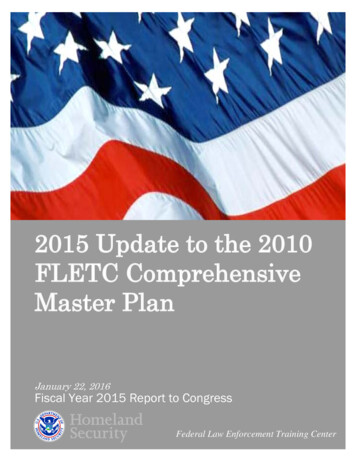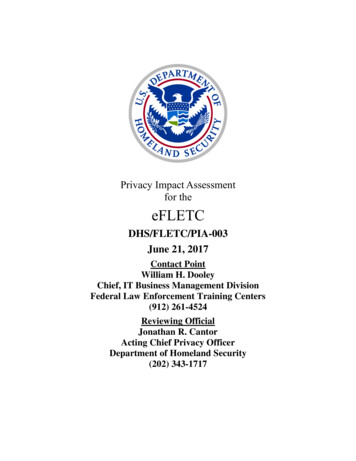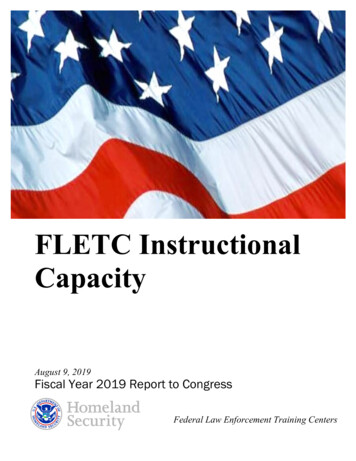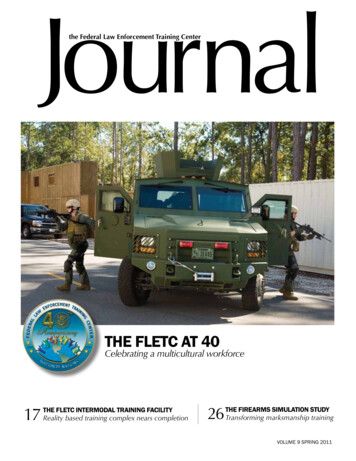
Transcription
2015 Update to the 2010FLETC ComprehensiveMaster PlanJanuary 22, 2016Fiscal Year 2015 Report to CongressFederal Law Enforcement Training Center
January 22, 2016
Executive SummaryThe Federal Law Enforcement Training Center (FLETC) submitted its original FacilitiesMaster Plan to Congress in June 1989. Since then, FLETC revised its plan on fouroccasions (August 1992, April 1996, October 2003, and July 2010) in response toevolving needs to create or enhance facilities that support the FLETC mission and goals.Guided by FLETC’s strategic goals, the 2015 Update to the 2010 Master Plan enhancesthe training that students experience and the physical environment that students, staff, andvisitors experience. It provides a tool to assist FLETC with implementation of strategicobjectives in a manner that maximizes resources for the use of all FLETC PartnerOrganizations following the principles of the consolidated training model.FLETC is positioned to be in compliance with the March 2015 Executive Order 13693;“Planning for Federal Sustainability in the Next Decade,” through its completion ofprojects such as the renovation of Glynco Building 680 from an old warehouse into aLeadership in Energy and Environmental Design (LEED) Silver sustainablewarehouse/office facility and the construction of a new LEED Silver Auditorium atArtesia, as well as the in-progress construction of a new LEED Silver Multi-PurposeCenter at Glynco and the planned construction of a Photovoltaic Solar Array system atCheltenham to reduce greenhouse gas emissions.This 2015 Update addresses several initiatives that were included in the FY 2010 FLETCComprehensive Master Plan, as well as construction or renovation of replacement andgrowth projects. The update addresses potential projects at all four sites, but does notprioritize projects. Cost estimates are not included for any of these potential projects;however, once a project has been approved for execution, cost estimates will be providedthrough the normal budget process. Funding may be provided by direct and/orreimbursable sources. This update anticipates open space development, facilities growth,infrastructure upgrades, and landscape enhancements that will unify, maximize the utilityof, and beautify the campuses as priorities and funding dictate. This report does notreflect a budget request or a resource commitment from DHS.ii
2015 Update to the 2010 FLETCComprehensive Master PlanTable of ContentsI.Legislative Language . 1II.Background . 2A. Methodology. 4III. Glynco, Georgia .A. Site Overview .B. Short-Term Development Plan .C. Long-Term Development Plan .77816IV. Artesia, New Mexico .A. Site Overview .B. Short-Term Development Plan .C. Long-Term Development Plan .18181922V.Cheltenham, Maryland .A. Site Overview .B. Short-Term Development Plan .C. Long-Term Development Plan .24242526VI. Charleston, South Carolina .A. Site Overview .B. Short-Term Development Plan .C. Long-Term Development Plan .28282931VII. Conclusion. 33iii
Appendices . 34Appendix A: Status of FLETC 2010 Development Plans by Site . 34Appendix B: Acronyms and Abbreviations . 37iv
I.Legislative LanguageThis report is in response to language in the Joint Explanatory Statement accompanyingthe Fiscal Year (FY) 2015 Department of Homeland Security (DHS) Appropriations Act(P.L. 114-4).Specifically, the Joint Explanatory Statement states:FLETC shall submit, not later than 180 days after the date of enactment ofthis Act, an updated five-year comprehensive master plan for its fourtraining centers.1
II. BackgroundThe Federal Law Enforcement Training Center (FLETC) was established on July 1, 1970,as a bureau within the Department of the Treasury. Originally located in WashingtonD.C., FLETC relocated its headquarters and main training center to a 1,500-acre site inGlynco, Georgia, in 1975. In 1989, FLETC expanded its operations to Artesia, NewMexico, with the purchase of a 2,200-acre site that now supports the basic and advancedtraining needs of the U.S. Border Patrol (USBP), Bureau of Indian Affairs (BIA), andother agencies. In 1996, a temporary center was established in Charleston, SouthCarolina, to provide USBP training. The Charleston site since has become permanent,and supports training for several Partner Organizations (PO) including U.S. Customs andBorder Protection (CBP), U.S. Coast Guard (USCG) Maritime Law EnforcementAgency, U.S. Immigration and Customs Enforcement, and U.S. Courts. In 2001, FLETCadded a 247-acre facility in Cheltenham, Maryland, for firearms and vehicle operationrequalification training for federal law enforcement officers in the metropolitanWashington, D.C. area.In March 2003, pursuant to section 403(4) of the Homeland Security Act of 2002(P.L. 107-296), FLETC became part of the newly created DHS. Since 2003, the FLETCmission to provide basic and advanced training has expanded from 76 to 96 POs. Inaddition, training of numerous state, local, and international organizations also hasgrown. FLETC currently is expanding its facilities to meet these growing lawenforcement training demands. In March 2006, FLETC completed the Federal LawEnforcement Training Accreditation (FLETA) process and became a fully accreditedacademy, providing assurance that FLETC has successfully achieved compliance with aset of standards collectively established by peers within the professional community thatdemonstrate adherence to quality, effectiveness, and integrity.FLETC encompasses 3,388.4 acres across its four domestic training delivery points andincludes modern facilities such as driving ranges, firing ranges, scenario-based trainingareas, and classrooms. Training support facilities include dining halls, indoor andoutdoor aquatic facilities, dormitories, logistical support facilities such as equipmentissue and uniform issue, a variety of physical fitness/techniques facilities, and variousrecreational facilities. Administrative facilities consist primarily of office spaces andassociated parking. In addition, there are numerous infrastructure systems such asboiler/chilled water plants; roadway, drainage, and utility grids; and informationtechnology (IT) cabling networks that are key support aspects for each of the trainingsites.Each of the four FLETC sites is addressed in sections labeled Glynco, Georgia; Artesia,New Mexico; Cheltenham, Maryland; and, Charleston, South Carolina. Each section2
includes an overview of the site and its location, placing each site in a historical and localcontext. Understanding the history assists in ensuring that this plan enhances andconforms to the legacy of each site. Each section also includes the Development Plan foreach site. These identify short-term (FY 2016 – FY 2020) and long-term (FY 2021 andbeyond) projects separated into four categories, as applicable: training, training support,administrative facilities, and IT or utility infrastructure.This 2015 Update to the 2010 Master Plan (MP) depicts thelist of projects under consideration at each FLETC site. Theupdate does not incorporate estimated funding required, nordoes it include an in-depth requirements analysis, includingsiting. Additionally, the public nature of this documentprecludes the inclusion of certain law enforcement sensitiveand/or “For Official Use Only” information that typicallywould be part of the master plan.FLETC Locations across the United StatesThis document responds to language included in Public Law 114-4, and contains anupdate of significant new construction and remodeling projects, site and utilitiesimprovement projects, IT infrastructure upgrades, and the proposed 5-year and beyondcapital plan for FLETC.FLETC is the DHS Component responsible for training our Nation’s federal lawenforcement officers. Due to the evolving and often emergent needs of law enforcementagencies worldwide, FLETC requires an update to its Comprehensive MP.Developments since the last Comprehensive MP (July 2010) include growth in thenumber of federal POs to nearly 100, and evolving training demands throughout the lawenforcement profession. The 2015 Update to the 2010 MP is critical to FLETC’s abilityto meet established and projected training goals.This 2015 Update to the 2010 MP focuses on the major acquisition and renovationprojects planned for the FY 2016 through FY 2020 period. It identifies programmaticneeds for training, training support, and administrative spaces, as well as neededupgrades to IT and utilities infrastructure. The update reflects various changes withinFLETC in recent years, and incorporates some of the work that FLETC has alreadyundertaken to programmatically integrate recommendations for capital investment acrossall four FLETC sites, as FLETC described in the 2010 FLETC Comprehensive MP. Thechanges reflected in this update are a direct result of more collaborative detailed planningby FLETC management and POs. These groups have considered current and projectedstaff; student workload; existing facility condition and usage; life safety; andenvironmental issues.FLETC anticipates that the demand for law enforcement training will increase in the next5 years and beyond. PO workload projections, including those received from DHS3
components such as CBP Field Operations and Border Patrol and the TransportationSecurity Administration (TSA) reflect an increase in both students and student weeks 1.FLETC will need to build additional facilities and renovate or replace aging facilities tomeet this projected training demand. For example, many of FLETC’s current facilitieswere neither designed nor built to accommodate new and improved technology in tacticstraining such as scenario-based simulators. Many office buildings are antiquated andinsufficient to accommodate current and projected numbers of staff and trainers, and intheir current configuration, do not meet DHS policies to reduce the footprint. FLETC’sappropriation includes funding for construction projects and authorizes FLETC to acceptfunds from POs to construct specific training venues based upon agency needs. In suchcases, FLETC retains ownership of the facility and provides all maintenance and support.A. MethodologyThe MP Update began with a kickoff meeting in April 2015 at FLETC-Glynco. FLETCconducted additional meetings through mid-July among FLETC leadership, training, andsupport staffs, as well as PO representatives, to gather input on projects for considerationfor inclusion in the MP Update. This was in keeping with the FLETC Director’s goal toinvolve the POs in the master planning process.During interviews, FLETC and PO staff discussed and documented current and shortterm needs, long-term vision, and future training expectations. The final step of theplanning process was creating the Development Plan, which includes lists of short- andlong-term projects for each site. Appendix A includes a list of the short-term projects,long-term projects, and the respective status for each site included in the FY 2010FLETC Comprehensive MP. Some projects not completed to date figure prominently inthis MP Update.FLETC’s interviews with internal stakeholders enterprisewide and with POrepresentatives led to a broader understanding of facility requirements, both in terms ofadded capacity and expanded capability. Guided by FLETC’s Strategic Plan, lawenforcement training requirements, and project criticality, FLETC developed a list oftactical projects requiring immediate attention within the next 5 fiscal years (FYs 2016–2020) and a list of more strategic projects requiring attention in the longer term (FY 2021and beyond). These projects are included in the narrative for each site.FLETC took a multifaceted approach to establish the facilities requirements and projectsidentified for future development, either short-term or longer-term, as described above.World events, training load fluctuations, technology advancements, and continual1The student week is calculated by multiplying the number of students enrolled times the duration in weeks of thetraining program the students attend. Thus, 48 students in a 12-week training program would be reflected in the dataas 576 ( 48 x 12) student weeks.4
variations in training program requirements complicate long-term planning and facilityrequirements. Several planning assumptions guided completion of this update. Demandfor training at FLETC will continue to grow, both with more students from some existingPOs and students from new POs; older facilities will continue to require replacement andrenovation; training demands will require new facilities; and FLETC will continue tooperate at its four existing training delivery points. Additionally, FLETC has notincluded utility systems and physical infrastructure as stand-alone items, although theyare essential to this plan.FLETC leadership reviewed and modified the list of projects, and FLETC developed amaster plan for each site in compliance with FLETC’s land use plan as outlined in theFY 2010 Comprehensive MP. Inclusion in the MP Update implies approval of theproject concept without making any commitments regarding the source and/or timing offunding. All of the projects in this MP Update reflect the philosophy of consolidatedtraining, which continues to be the foundation for FLETC’s success in maximizingtraining resources to meet the law enforcement training needs of its 96 POs.Planning Parameters and SustainabilityExecutive Order (EO) 13514, “Federal Leadership in Environmental, Energy andEconomic Performance” of October 2009 required that all federal facilities achieve theminimum standards for LEED Silver. EO 13693, “Planning for Federal Sustainability inthe Next Decade,” of March 2015 revoked EO 13514 but retains the requirement forLEED Silver in federal facilities. FLETC has been committed to sustainable andenvironmentally friendly construction and renovation projects as part of efforts to becompliant with both Executive Orders, beginning with the design and construction of theEquipment Issue Building 39 at Glynco in 2008. The development of high-performance,energy-efficient, and environmentally safe buildings enables FLETC to better protectnatural resources and reduce impacts on the natural environment. The commitment ofFLETC’s design team to engage in the integrated design process is critical to the successof sustainable design and development. Integrated design is a more inclusive effort,which requires future building users and facility managers to join architects, engineers,and planners in developing the vision and goals for new facilities.Site PlanningThe FLETC 2010 Facility Design Guide (FDG) provides sustainable site design practicesas well as standards and guidance for standardizing and improving the quality of the totalvisual environment of the FLETC sites. The FDG serves as a reference guide whenmaking recommendations for the design and modification of all facilities, roads, parking,sidewalks and other pedestrian paths, bicycle paths, and access control points. The FDGincludes general guidelines for the following design issues: site planning, architecturalcharacter, colors and materials, vehicular and pedestrian circulation, and landscape5
elements. It also addresses site furnishings, signage, lighting, and plant materialsselection and placement.Administrative Space PlanningOn September 30, 2014, the DHS Chief Readiness Support Officer released Instruction119-02-003, “DHS Workspace Standard (Standard).” The Standard allows Componentsthe flexibility to plan, design, and deliver effective office space that meets theDepartment’s mission support requirements. The Standard focuses on improving ways ofdeveloping office space requirements based on functional mission spaces to increase theefficiency of the DHS footprint, lower facility costs, and deliver the Department’s goal of150 or fewer usable square feet per person.Some of the workspace standards, such as desk sharing and hoteling workstations, maynot be appropriate for training support staff who need to be onsite to perform their tasks.However, the concept of hoteling is in place in some FLETC organizations for temporaryand detailed staff. For staff such as instructors who spend a significant amount of timeaway from their offices, open workstations with unassigned workspaces may work well.For work positions in which a more secure environment is required, such as for managersand supervisors, dedicated private workspaces should be provided.Federal Flood Risk Management StandardEO 13690 2, “Establishing a Federal Flood Risk Management Standard (FFRMS),” issuedby President Obama in January 2015 amends EO 11988, “Floodplain Management,”which went into effect in May 1977. As FLETC plans future MP projects, it willconsider climate change in predicting flood risk in the context of federal capitalinvestments. Under EO 13690, the FFRMS will apply to new construction andsubstantial improvements to existing structures in floodplains and other low-lying areas.Incorporating the new standard will ensure that federal agencies expand managementfrom the current base flood level to a higher vertical elevation and correspondinghorizontal floodplain to address current and future flood risk and to ensure that projectsfunded with taxpayer dollars last as long as intended.2The new EO is currently under review by the Water Resources Council; any changes to the standard will beincluded in the final legislation. FFMRS standards will be included in the design of the projects listed in this planonce final guidelines and a timeline for implementation of this order is received from DHS.6
III. Glynco, GeorgiaA. Site OverviewHistory of Facility and SiteThe current site of FLETC Glynco was originally the Glynco Naval Air Station (NAS),situated on more than 2,400 acres of flat pinelands and palmetto swamp. The air stationwas the operating base for Airship Squadrons One and Two, and Fleet Airship WingThirty from 1943 to 1945. Glynco NAS was built for the Navy fleet of airships thatpatrolled the coasts for marauding German submarines during World War II (WWII). Itplayed an important role in the defense of the southern Atlantic coast during WWII, andgreatly contributed to the cultural and economic life of Brunswick and Glynn County.The Navy selected this location for airshipoperations because of accessibility to theAtlantic Ocean eight miles to the east.Furthermore, a lack of air hazards offered bynearby marshes and the availability of goodwater, adequate electrical power, and railtransportation made it a strategic position forNavy patrollers.Glynco underwent many changes during the1950s and 1960s, including severalredesignations, the combined presence of both airships and airplanes, and newconstruction. Construction included an 8,000-foot jet airstrip, which is now part of theBrunswick Golden Isles Airport, a five-story control tower, operations building, newbarracks, new Bachelor Officers’ Quarters, boiler plant, and the Combat InformationCenter Training Building. Many of these permanent buildings replaced WWII-erastructures. Throughout the 1960s and 1970s, most of the former barracks, townhouses,single-family residences, and the dining facility were constructed. Later, many of thehousing quarters from this era were converted into office space and training facilities.FLETC came to Glynco, Georgia, in the summer of 1975 and began conducting trainingin September of that year. In January of 1976, the General Services Administrationtransferred 1,524 acres of the NAS to the Department of the Treasury for use as theFLETC campus. Many of the existing buildings at Glynco originally were constructedwhen the facility served as a military base. At least 15 structures remain that were builtduring WWII. At this time, many of these structures are in poor condition and requiredemolition and replacement because they are not structurally sound enough to berepurposed.7
By 1984, FLETC Glynco had approximately 800 employees and an average of 1,400 to1,600 students on the grounds at any one time, with 14,000 graduating that year. Asenrollment grew, so did the construction of driver and firearms ranges, dormitories, andclassrooms. To accommodate the growing needs and requirements of FLETC and POs,FLETC continually renovated and reconfigured old barracks, townhouses, and singlefamily residences. As time went on, FLETC began utilizing trailers and modular units tohelp satisfy space requirements.Today, Glynco is the largest of the four FLETC sites, both in terms of real estateownership and student throughput.Location/SettingGlynco is located in Glynn County, Georgia, on approximately 1,580 acres north ofBrunswick, Georgia. It is approximately 60 miles south of Savannah, Georgia, andapproximately 60 miles north of Jacksonville, Florida. Glynco is bordered on the northby the Brunswick Golden Isles Airport and by traditional suburban landscape in all otherdirections. Glynco has one remote site for marine training at Two Way Fish CampMarina, located approximately nine miles north of the main center along U.S. Highway17 near the South Altamaha River. Predominately single-family residentialneighborhoods surround Glynco to the east, south, and west. Particularly to the east andsouth, these neighborhoods abut the FLETC boundary. A school with kindergartenthrough 12th grade (K-12) is directly adjacent to the site at the southeast corner. A smallcommercial strip is located directly south of the visitor control center, and several othercommercial/retail land uses are located further to the south and west of the site.The Brunswick Golden Isles Airport borders the northern boundary of Glynco. Theairport does not restrict any type of training, but does restrict the height of buildings inthe northern portion of Glynco. There are industrial uses to the northeast of the site.FLETC recently purchased several parcels of land in this industrial area, including nearly17 acres north of the Explosives Range along Glynco Parkway. These parcelscomplement Buildings 2200 and 2400 and will prevent incompatible future uses in theindustrial area.B. Short-Term Development Plan 3Projects included in the short-term development plan are categorized as follows: training, which includes projects that are directly involved in the delivery of lawenforcement training, such as classrooms, driving ranges, or firing ranges;3Projects that are new since the development of the 2010 FLETC Comprehensive Master Plan are marked with anasterisk.8
training support, which includes projects that facilitate the delivery of training,such as student housing, student dining, or instructor offices; administrative support, which includes projects to house staff who facilitate theprovision of services necessary to deliver training, such as finance, procurement,or human capital; and, IT or utilities infrastructure, which includes projects necessary to ensure theavailability of IT support or utilities, such as fiber optic cabling, chillers, or sewersystems.Unless otherwise specified, funding for the projects listed is presumed to come fromdirect sources, secured in accordance with DHS budget guidance. For projects requestedby federal customers, generally referred to as POs, the funding is presumed to beprovided by the agency making the request. Those projects will be identified asanticipating funding.Training1. New Aircraft Countermeasure Complex*Glynco currently has two 727 aircraft that serve as a training platform for aircraftcountermeasures training. The new aircraft countermeasure complex will expand thecurrent training capability and include two 48-person classrooms and four aircraftsimulators.2. New Counterterrorism Operations Training Facility Road Course with Façades andJunker Alley*FLETC will construct a façade at Driving Range 6 to duplicate the CounterterrorismOperations Training Facility course at Building 76. Increased use of the current rangecontributes to the need to plan for added capacity. Constructing façades on all four highspeed driving ranges 6, 7, 8, and 9 will enhance capabilities for advanced training.3. New Boat Ramp at Skid Pan 6*Currently, FLETC’s Driver and Marine Division (DMD) conducts a 4-hour boat classthat uses two boats and two trucks at a public ramp (Two Way Fish Camp Marina).FLETC frequently must interrupt or discontinue training to allow public use. This newboat ramp on the FLETC property would allow training without interruptions. The newramp with an accompanying pavement for boat turning is needed. Once completed, itwill save both travel time and fuel, and will eliminate conflicts associated with public useof the existing ramp. The projected site for the ramp is at an existing pond that isadjacent to Skid Pan 6 of the Driver Training Complex.4. New Use-of-Force Facility*FLETC currently conducts use-of-force training in a large outdoor complex that supportsa variety of scenarios for students to demonstrate their judgment in applying appropriate9
force. The existing complex also accommodates multiple classes simultaneously. Sinceit is an outdoor complex without overhead cover, it cannot be used during inclementweather and it is susceptible to flooding that makes portions of the complex unusable.While there is a tactics venue within the Danis City Training Complex that is used toaccommodate additional capacity and during severe weather, the space is not configuredfor use-of-force training, the size is not adequate, and there is not sufficient soundmuffling when used for this type of training. A dedicated use-of-force training facility,separate from other tactical facilities, is necessary because while basic tactics can betaught in close proximity to other groups of students, use-of-force training is bestaccomplished in an environment where students can assess a larger, evolving situationand apply judgment on applying force.5. New Training Tank/Pool for Underwater Egress Training*The DMD is in need of a new tank/pool in which to conduct underwater egress training.The tank/pool must be large enough to accommodate a simulated submersible vesselcabin and a 50-foot underwater maze with the capability to create various size waves tosimulate a variety of sea conditions. The tank/pool must be of sufficient size tosimultaneously accommodate the underwater submersible vessel, maze, and four eightperson life rafts. This training currently takes place at the indoor pool located in thePhysical Techniques Complex, which staff and agencies also use for physicalconditioning and water survival training. The training that DMD provides in the currentpool is attended by USBP, CBP Air and Marine Basic, and the U.S. Park Police, U.S.Secret Service, Naval Criminal Investigative Service, Federal Bureau of Investigation,USCG, U.S. Fish and Wildlife Service, National Marine Fisheries Service, National ParkService, U.S. Capitol Police, U. S. Forest Service, and a multitude of state and localagencies attending the Marine Law Enforcement Training Program. These agencieswould be the primary users of the new facility. Additionally, FLETC recently created a2-day program for USCG for underwater egress training that is primarily in the pool andis offered 24 times per year with pending requests for more annually. The current poolwould continue to be available for agency-specific water survival training andconditioning classes.6. Establish Facilities for FLETC Leadership Institute*Building 90 is currently the FLETC Auditorium and the site for class graduations. Afterthe completion of the Multi-Purpose Building 912, Building 90 will be repurposed andrenovated for the FLETC Leadership Institute. The FLETC Leadership Institutecurrently offers five training programs, including the Law Enforcement SupervisorTraining Program, the Leadership through Understanding Human Behavior Program, theSituational Leadership Training program, the Women in Law Enforcement TrainingProgram, and the Leadership in a Crisis Training Program. Collectively, FLETC trainedmore than 1,300 students in th
The Federal Law Enforcement Training Center (FLETC) was established on July 1, 1970, as a bureau within the Department of the Treasury. Originally located in Washington D.C., FLETC relocated its headquarters and main training center to a 1,500-acre site in Glynco, Georgia, in 1975. In 1989, FLETC expanded its operations to Artesia, New










